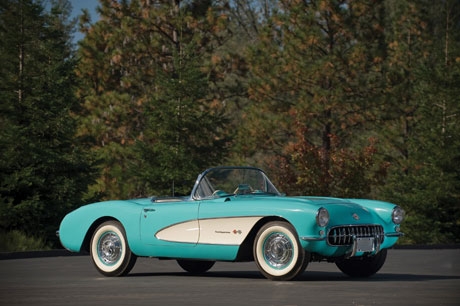While the original Corvettes of 1953–54 were more suited to stylish cruising, a performance boost quickly followed, thanks to Zora Arkus-Duntov, who skillfully guided the Corvette’s transformation into a potent sports car. The addition of the powerful, small-block 265-ci V8 engine in 1955 was a welcome first step in the process, while a major exterior restyling for 1956 provided a much-needed kick on the showroom floor.
Although the 1957 Corvette remained virtually identical in appearance to 1956, the big news came in the form of the enlarged 283-ci small-block V8 engine, destined to become a performance icon. The highest specification benefited from a Rochester mechanical fuel injection unit, a compression increase, and a high-lift mechanical camshaft, good for 283 hp. As a result, the 1957 Corvette famously became just the second American production car to develop one horsepower per cubic inch of displacement (the first was the 1956 Chrysler 331-ci Hemi, which put out 355 hp).
Just 1,040 Corvettes were equipped with the fuel-injection option for 1957, and they were capable of acceleration from 0–60 mph in six seconds, en route to top speeds approaching 130 mph. These cars quickly became favorites of sports car racers, who recognized that the fuel-injection system provided a precise, surge-free fuel supply to the engine during competition. A growing list of heavy-duty suspension and braking options was also available, and very soon, the Corvette began dominating SCCA events.
Equipped with the impressive 283-ci/283-hp, fuel-injected V8 engine, this 1957 Corvette is a former NCRS Top Flight award-winning example that continues to benefit from its older body-off restoration. While fuel-injected early Corvettes are already quite rare, the car offered here is even more so, being one of 664 Corvettes equipped with the new-for-1957 4-speed manual transmission, as well as one of just 327 examples equipped with a 3:70:1 Positraction rear axle.
Other desirable attributes include a turquoise exterior finish with white coves, a tan convertible top, a 6,000-rpm tachometer, a Wonderbar pushbutton-operated AM radio, full bright wheel covers, body-color steel wheels, and wide whitewall tires. Offered complete with an original owner’s manual, this fuelie 1957 Corvette is one of the greatest performance icons ever to come from Detroit.
SCM Analysis
Detailing
| Vehicle: | 1957 283/283 Fuel-Injected Convertible |
| Years Produced: | 1957 |
| Number Produced: | 1,040 Fuel-Injected (6,339 total) |
| Original List Price: | $4,115.77 |
| SCM Valuation: | $72,000–$120,000 |
| Tune Up Cost: | $150 |
| Distributor Caps: | $19.99 |
| Chassis Number Location: | VIN plate on the steering column |
| Engine Number Location: | Pad on front of block below right cylinder head |
| Club Info: | National Corvette Restorers Society 6291 Day Rd. Cincinnati, OH 45252-1334 |
| Website: | www.ncrs.org |
| Alternatives: | 1959 Jaguar XK 150; 1955–57 Ford Thunderbird; 1959 Daimler SP250 |
| Investment Grade: | A |
This car sold for $115,500, including buyer’s premium, at RM’s Automobiles of Arizona Auction in Phoenix, Arizona, on January 22, 2010.
When you think of the great American designs of the 1950s, cars like the 1955–57 Chevys and Thunderbirds, the Chrysler 300 series cars, and the Corvette come to mind. But as much as fins and chrome defined the era, so too did the rainbow of available colors on these cars. Pastels in two-tones and even three-tones reflected the exuberant mood of the times, just as the psychedelic colors of the late ’60s defined that era and the dreary browns, beiges, and navy blues bring to mind the 1970s.
460 color combinations on 1957 Chevys
Harley Earl established the world’s first automotive design studio in 1929—General Motors’s Art & Colour Section—and he clearly recognized that color was an important aspect of good design. In fact, GM was the pioneer in the way cars are painted today, having worked with DuPont to create the sprayed nitrocellulose lacquers they introduced in the early 1920s.
By the 1950s, the Art & Colour Section had evolved into GM Styling, with responsibility for everything from Frigidaire refrigerators to Electromotive locomotives. “Colour” may have been dropped from the department’s name, but their use of color soared to new heights. And when someone complained to Chevrolet president Ed Cole about the 460 different color combinations on the 1957 Chevy sedans, he simply said, “It will take more than styling to sell these cars.”
Corvettes that year had just seven colors to choose from, either in monotone or with contrasting “coves.” The magic of one-horsepower-per-cubic-inch for the fuelies and a new slick-shifting 4-speed gearbox—along with racing victories at Sebring and elsewhere—just added to the mystique. Then there is the updated styling that was introduced the year before. Harley Earl once remarked,“You can design a car so that every time you get in it, it’s a relief—you have a little vacation for a while.” The ’57 Corvette was one of those cars.
You can repaint a C1 Corvette any color you like
Out of the 6,339 Corvettes built in 1957, fully 75% were painted either Onyx Black, Polo White, or Venetian Red. Personally, I’d rather be in the 25% who chose Aztec Copper, Inca Silver, Arctic Blue, or, my favorite, Cascade Green. But since first-generation Corvettes do not have a trim tag, when restoring one of these cars you can really paint it any one of the colors available that year, and it seems the majority of restored ’57s are black or red.
That’s probably done to make them more marketable—black and red are historically the most popular Corvette colors—but I tend to think it’s the period panache of this Cascade Green ’57 that bumped it almost to high book, which is $120k.
At this price, in this condition, I would say that both buyer and seller should be pleased
